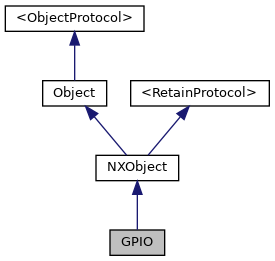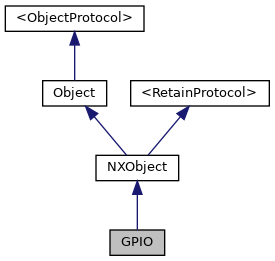#import <Application/Application.h>


Instance Methods | |
| (uint8_t) | - pin |
| Returns the pin number. | |
| (bool) | - isInput |
| Returns true if the GPIO pin is configured as an input. | |
| (bool) | - isOutput |
| Returns true if the GPIO pin is configured as an output. | |
| (BOOL) | - state |
| Returns the state of the GPIO pin. More... | |
| (void) | - setState: |
| Sets the state of the GPIO pin. More... | |
 Instance Methods inherited from NXObject Instance Methods inherited from NXObject | |
| (id) | - retain |
| Increases the retain count of the receiver. More... | |
| (void) | - release |
| Decreases the retain count of the receiver. More... | |
| (id) | - autorelease |
| Adds the receiver to the autorelease pool. | |
 Instance Methods inherited from Object Instance Methods inherited from Object | |
| (void) | - dealloc |
| Free resources for an existing instance. | |
| (id) | - init |
| Initialize the instance, after allocation. More... | |
| (Class) | - class |
| Returns the class of the instance. More... | |
| (Class) | - superclass |
| Returns the superclass of the instance. More... | |
| (BOOL) | - isEqual: |
| Compares the receiver to another object for equality. More... | |
| (BOOL) | - isKindOfClass: |
| Returns a Boolean value that indicates whether the receiver is an instance of a given class. More... | |
| (BOOL) | - conformsTo: |
| Checks if the receiver's class conforms to a protocol. More... | |
| (NXString *) | - description |
| Returns a string that represents the instance. More... | |
 Instance Methods inherited from <ObjectProtocol> Instance Methods inherited from <ObjectProtocol> | |
| (BOOL) | - respondsToSelector: |
| Checks if the receiver responds to a selector. More... | |
Class Methods | |
| (GPIO *) | + inputWithPin: |
| Returns a GPIO input instance. More... | |
| (GPIO *) | + pullupWithPin: |
| Returns a GPIO input instance, with pull-up resistor enabled. More... | |
| (GPIO *) | + pulldownWithPin: |
| Returns a GPIO input instance, with pull-down resistor enabled. More... | |
| (GPIO *) | + outputWithPin: |
| Returns a GPIO output instance. More... | |
| (uint8_t) | + count |
| Returns the total number of GPIO pins available. More... | |
| (void) | + setDelegate: |
| Sets the delegate for GPIO events. More... | |
| (id< GPIODelegate >) | + delegate |
| Returns the current delegate for GPIO events. More... | |
 Class Methods inherited from NXObject Class Methods inherited from NXObject | |
| (id) | + allocWithZone: |
| Allocates a new instance of an object in a specific memory zone. More... | |
 Class Methods inherited from Object Class Methods inherited from Object | |
| (void) | + initialize |
| Performs one-time initialization for the class. More... | |
| (id) | + alloc |
| Allocate a new class instance. More... | |
| (Class) | + class |
| Returns the class object. More... | |
| (Class) | + superclass |
| Returns the superclass of the class. More... | |
| (const char *) | + name |
| Returns the name of the class. More... | |
| (BOOL) | + conformsTo: |
| Checks if the class conforms to a protocol. More... | |
| (NXString *) | + description |
| Returns a string that represents the class. More... | |
Additional Inherited Members | |
 Protected Attributes inherited from NXObject Protected Attributes inherited from NXObject | |
| id | _zone |
| The memory zone where the object is allocated. | |
| unsigned short | _retain |
| The retain count of the object. | |
| id | _next |
| The next object in an autorelease pool. | |
 Protected Attributes inherited from Object Protected Attributes inherited from Object | |
| Class | isa |
| A pointer to the object's class structure. More... | |
Detailed Description
The GPIO class.
GPIO represents a class for controlling General Purpose Input/Output (GPIO) pins.
- Examples:
- examples/Application/gpio/main.m.
Method Documentation
◆ count()
| + (uint8_t) count |
◆ delegate()
| + (id<GPIODelegate>) delegate |
◆ inputWithPin:()
| + (GPIO *) inputWithPin: | (uint8_t) | pin |
Returns a GPIO input instance.
- Parameters
-
pin The GPIO pin number to configure as input.
- Returns
- A new GPIO instance configured for input, or nil if the pin is invalid or initialization failed.
This method creates a GPIO instance configured as a floating input pin. The pin will not have any internal pull-up or pull-down resistors enabled, so external circuitry should be used to ensure proper logic levels.
- Note
- The pin number must be valid for the target platform.
- See also
- + pullupWithPin: for input with pull-up resistor
- + pulldownWithPin: for input with pull-down resistor
◆ outputWithPin:()
| + (GPIO *) outputWithPin: | (uint8_t) | pin |
Returns a GPIO output instance.
- Parameters
-
pin The GPIO pin number to configure as output.
- Returns
- A new GPIO instance configured for output, or nil if the pin is invalid or initialization failed.
This method creates a GPIO instance configured as an output pin. The initial state of the pin is platform-dependent and should be explicitly set using setState: after creation.
- Note
- The pin number must be valid for the target platform.
- See also
- - setState: for controlling the output - state
◆ pulldownWithPin:()
| + (GPIO *) pulldownWithPin: | (uint8_t) | pin |
Returns a GPIO input instance, with pull-down resistor enabled.
- Parameters
-
pin The GPIO pin number to configure as input with pull-down.
- Returns
- A new GPIO instance configured for input with pull-down, or nil if the pin is invalid or initialization failed.
This method creates a GPIO instance configured as an input pin with the internal pull-down resistor enabled. The pin will read as logical low (0) when not driven high by external circuitry.
- Note
- The pin number must be valid for the target platform.
- See also
- + inputWithPin: for floating input
- + pullupWithPin: for input with pull-up resistor
◆ pullupWithPin:()
| + (GPIO *) pullupWithPin: | (uint8_t) | pin |
Returns a GPIO input instance, with pull-up resistor enabled.
- Parameters
-
pin The GPIO pin number to configure as input with pull-up.
- Returns
- A new GPIO instance configured for input with pull-up, or nil if the pin is invalid or initialization failed.
This method creates a GPIO instance configured as an input pin with the internal pull-up resistor enabled. The pin will read as logical high (1) when not driven low by external circuitry.
- Note
- The pin number must be valid for the target platform.
- See also
- + inputWithPin: for floating input
- + pulldownWithPin: for input with pull-down resistor
◆ setDelegate:()
| + (void) setDelegate: | (id< GPIODelegate >) | delegate |
◆ setState:()
| - (void) setState: | (BOOL) | state |
Sets the state of the GPIO pin.
- Parameters
-
state true to set the pin high (logical 1), false to set low (logical 0).
◆ state()
| - (BOOL) state |
Returns the state of the GPIO pin.
- Returns
- true if the pin is high (logical 1), false if low (logical 0).
The documentation for this class was generated from the following file:
- include/Application/GPIO.h